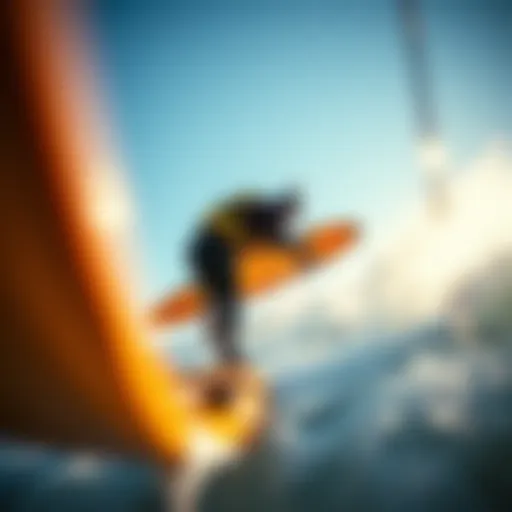GoPro Hero3: The Best Choice for Kiteboarding Filmmakers
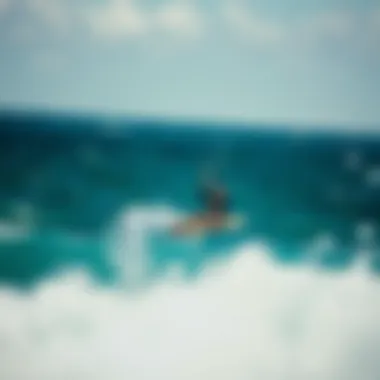

Intro
In the exhilarating world of kiteboarding, where the wind and waves dictate the pace, capturing the essence of each ride requires not just skill on the board but also the right equipment. For those stepping into this thrilling sport with the aim to document their adventures, the GoPro Hero3 stands out as a top choice. This camera’s compact size and impressive capabilities make it perfect for capturing fast-paced action on the water, and its durability means it can handle being tossed around by both sea and sky. This guide will explore why the Hero3 is particularly suited for kiteboarding enthusiasts and what techniques can be employed to maximize its potential.
Techniques for Kiteboarding Enthusiasts
Having the right gear is half the battle; knowing how to use it effectively is the other half. Let’s delve into some techniques both novice and experienced kiteboarders can adopt, alongside tips for filming with the GoPro Hero3.
Beginner Techniques
For those just starting out in kiteboarding, it’s vital to learn the basics while capturing those early successes. Here are some initial techniques to focus on:
- Body Positioning: Keep your knees slightly bent and maintain a low center of gravity to enhance stability. This not only helps in riding smoothly but also frames better shots for the GoPro.
- Controlled Turns: Start with gentle turns and figure eights in calm waters. Use the Hero3 to film these moments, ensuring the camera is securely fastened, perhaps using a helmet mount, to reduce shake.
- Trick Basics: Simple tricks like the "kitesurf jump" can be a solid starting point for filming. Capture these attempts from different angles to make the footage more engaging.
Advanced Maneuvers
As your skills evolve, so should your filming techniques. Advanced kiteboarders can explore these techniques while using the GoPro:
- Dynamic Angles: Experiment with various mounts like chest or handlebar mounts. A lower angle can accentuate the speed and thrill of maneuvers such as aerial spins.
- Multiple Cameras: For seasoned riders, using multiple GoPros can create a more thrilling narrative. Position one on the board and another on a drone or a friend.
- Editing Techniques: Post-capture editing is crucial in bringing out the best in your footage. Using software like Adobe Premiere or Final Cut Pro can help you sync music to high-energy moments, blend clips smoothly, and even enhance colors for visual appeal.
"Filming kiteboarding is like painting with wind and water – the brushstrokes are made with your moves and the colors come alive in the editing room.”
With these techniques in hand, you can begin to document your kiteboarding journey in ways that truly reflect the adventure. Whether you're shooting a personal montage or aiming to inspire others, the GoPro Hero3 can play an essential role in ensuring those memories are vivid and exciting.
Preface to the GoPro Hero3
The GoPro Hero3 has carved out a niche for itself among action cameras, becoming a favored tool for those seeking to document their adrenaline-fueled activities. This scrutiny into the Hero3 isn't just a routine exploration; it underscores a critical shift in how enthusiasts capture their experiences. Kiteboarding, with its dynamic motion and breathtaking settings, requires a camera that not only captures high-quality visuals but also withstands the rough and tumble of the environment. This section aims to impart an understanding of why the GoPro Hero3 stands out, particularly for kiteboarding filmmakers.
The Rise of Action Cameras
Over the past decade, action cameras have witnessed a meteoric rise in popularity. Think back to the days of bulky camcorders—how cumbersome they were for capturing spontaneous moments. With the advent of smaller, lighter cameras, like the GoPro Hero3, anyone can document their adventures without lugging around heavy equipment. This camera has democratized filmmaking, allowing novice users and seasoned videographers to create stunning visuals with ease.
The action camera game changer also brings versatility. The Hero3 launched a range of accessible, high-definition content creation, enabling users to film everything from the serene beauty of a sunrise to the chaos of a high-speed kiteboarding session. The rugged and compact design of these cameras means you can take them virtually anywhere. This has led to a surge in user-generated content, flooding social media platforms with jaw-dropping footage, inspiring others to participate in action sports.
Why Choose a GoPro
When it comes to action cameras, GoPro often sits atop the throne. But what keeps it reigning strong in a crowded market?
- Reputation and Reliability: GoPro has built its brand on a foundation of high performance in challenging conditions. Users trust that their GoPro won't let them down when they need it most.
- User-Friendly Design: Ease of use is paramount. The Hero3 is designed for all skill levels, making it simple for anyone to pick up and start recording without extensive technical knowledge.
- Quality Footage: With a reputation for providing stunning image quality, the Hero3 films in resolutions that can showcase the best of kiteboarding. Whether it’s bright sunlight or tumultuous conditions, this camera captures thrilling action moments with clarity.
- Community and Support: The GoPro community is vast and supportive. With numerous online forums such as going through Reddit discussions on www.reddit.com/r/gopro and tutorials on platforms like YouTube, filmmakers can find a wealth of tips and tricks to enhance their shooting skills further.
Key Features of the GoPro Hero3
The GoPro Hero3 stands out in the action camera market due to its distinctive features and capabilities. Kiteboarding, a sport brimming with excitement and energy, demands a camera that can keep pace with its rapid movements and harsh conditions. The key features of the Hero3 make it an exemplary choice for capturing those thrilling moments on the water. Let's delve into the specifications, durability, design, and performance aspects that significantly enhance the kiteboarding experience.
Camera Specifications
Image Quality
When it comes to image quality, the GoPro Hero3 delivers striking clarity and detail, crucial for vividly capturing kiteboarding actions. With a 12-megapixel sensor, it excels in producing sharp, high-resolution images. What truly makes it shine is its capability to shoot in various formats, which appeals to both professionals and hobbyists. For kiteboarders, this means every splash, jump, and maneuver can be documented with a precision that enhances the viewer's experience. However, it's good to note that in bright sunlight, some might find the highlights can easily clip if the settings aren't adjusted right, which could mask those exhilarating moments.
Resolution Options
The GoPro Hero3 offers impressive resolution options, allowing users to choose between 4K, 2.7K, and 1080p as filming resolutions. The ability to shoot in 4K at 15 frames per second is particularly beneficial for those looking to create ultra-high-definition videos. This level of resolution captures the vibrant colors of the water and the fine details of kiteboarding gear, enriching the visual storytelling. That said, filming at the highest resolutions consumes more storage and battery life, so a balance is often needed based on the day's shooting conditions.
Field of View
Field of view (FOV) is another critical feature that impacts the storytelling capability of kiteboarding films. The Hero3 provides three FOV options: narrow, medium, and wide. This adjustable setting lets filmmakers get creative—wide captures more of the surroundings, making it easier to convey the scale of the kiteboarding adventure, while narrow focuses more on the subject. Choosing the right FOV is essential; while a wide FOV can encapsulate a breathtaking scene, it might also introduce distortion on the edges. For athletes seeking to capture their skills up close, a narrower setting may yield better results.
Durability and Design
Water Resistance
An essential aspect for any kiteboarding camerawoman or man is water resistance. The GoPro Hero3 is built to withstand wet conditions, allowing users to dive into the ocean and still capture their adventures without fear of damaging the equipment. Rated to handle depths of up to 40 meters, it is specifically designed for water sports enthusiasts. However, it's worth considering that the camera's effectiveness can diminish in murky water, limiting visibility in certain conditions.
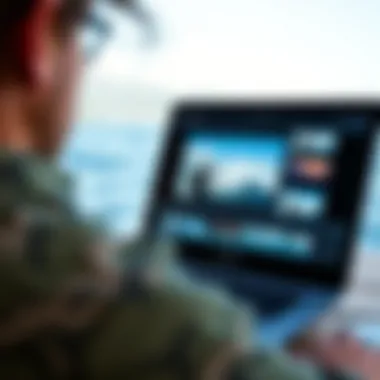

Shock Proofing
Designed with adventurers in mind, the Hero3 features robust shock proofing that ensures it can endure falls and bumps from various activities. This durability is significant for kiteboarders who may experience abrupt landings or waves crashing into them. Yet, despite this resilience, it's prudent to handle the device with care; extreme impacts can still lead to damage despite its sturdy build.
Size and Portability
In terms of size and portability, the GoPro Hero3 is exceptionally compact. Weighing less than 100 grams, it’s lightweight and easy to carry, making it a perfect companion for kiteboarding sessions. The small design allows it to fit on various mounts without adding unnecessary bulk. A downside might be that its size can lead to some challenges in stability; users may need to employ additional stabilization tools to ensure steady footage during high-octane performances.
Battery Life and Storage
Battery Performance
The battery performance of the Hero3 is fairly solid for a compact camera, offering around two hours of life at moderate settings and can be extended with power-saving modes. However, filming in high-definition or 4K can significantly shorten battery life, which can be inconvenient during an extended kiteboarding outing. Understanding how and when to manage battery usage will greatly enhance the filming experience.
Storage Options
The Hero3 utilizes microSD cards for storage, supporting cards up to 64GB. This is beneficial for kiteboarders who often film long clips or a series of action shots. Choosing high-speed cards can also ensure smooth recording, crucial for the fast-paced nature of the sport. Unfortunately, lower-quality cards can cause lag or data loss, marring the experience.
Video Duration Limits
Regarding video duration limits, the Hero3 allows continuous recording until the storage limit is reached, but users should be mindful that long videos might require longer editing processes. Each recording might attract users to capture the entire kiteboarding session in one go, yet breaking it into shorter clips can often provide better focus on key moments.
In summary, the features of the GoPro Hero3 create an alluring package for kiteboarding filmmakers. From its impeccable image quality to durable design and versatile specs, it remains an intriguing option for those keen on immortalizing their water sport adventures.
Optimizing the GoPro Hero3 for Kiteboarding
Optimizing the GoPro Hero3 for kiteboarding is crucial for capturing those exhilarating moments on the water. Kiteboarding enthusiasts know that the thrill of soaring through the air or carving through waves needs to be preserved with the highest quality possible. Therefore, optimizing your camera settings and mounting techniques can make a significant difference in the footage you produce. Each element, from how you mount the camera to how you set it up, contributes to the overall effectiveness of your recordings.
Mounted and Handheld Shots
Using mounted and handheld shots effectively can enhance the storytelling aspect of your kiteboarding videos. Different mounting techniques provide unique perspectives, allowing for dynamic footage.
Helmet Mounting
Helmet mounting is a favored choice among many kiteboarders. It gives a first-person perspective, putting the viewer right in the action. The camera's position on the helmet captures every movement and thrill as if the viewer is experiencing it themselves.
One of the key characteristics of helmet mounting is its ability to offer stability. Unlike handheld shots, which can be shaky, fastening the camera to a helmet minimizes unwanted movements. However, it comes with its downsides, such as being able to capture only what is directly in front of you—missing the action from other angles can sometimes be a drawback.
Chest Mounting
Chest mounting serves as another popular method, and for a good reason. This technique captures a different perspective, emphasizing both the kite and its rider. The unique features of chest mounting include a lower vantage point that can portray the rider’s movements and emotions more vividly, making it highly effective for storytelling.
Although chest mounting can provide a richer view of the action, it may compromise image stability compared to helmet mounting. While it offers a broader field of view, the camera’s movements more directly mimic the rider’s, which can lead to shaky footage if not adequately managed.
Handheld Techniques
Handheld techniques offer a level of versatility that mounted shots may lack. By holding the camera, riders can capture unique angles and close-up shots that sometimes elevate the viewing experience. Such fluidity allows for spontaneous shots; however, these can sometimes result in instability if not controlled properly.
One of the standout features of handheld techniques is the intuitive ability to maneuver the camera swiftly, allowing for creative framing and artistic captures. But it’s essential to be mindful of the challenges posed by shaky footage, necessitating proper handling techniques to mitigate this issue.
Setting Up the Camera
An essential part of optimizing the GoPro Hero3 is setting it up correctly for capture. Settings can make or break your footage quality, so fine-tuning them is key.
Preferred Settings
Establishing your preferred settings is foundational for the entire shooting process. Factors like resolution and frame rate can optimize the camera for the specific conditions you'll be shooting in, ensuring the best possible footage. Adjusting these settings based on the light conditions and motion of the action will help enhance the video significantly.
One of the most notable characteristics of preferred settings is the importance of resolution, particularly in a water sport environment where clarity can make a huge difference. Some may overlook basics like adjusting the field of view to match the shot, which can also impact the audience's perception considerably.
Aspect Ratios
Aspect ratios play a subtle yet pivotal role in video compositions. The GoPro Hero3 allows users to switch between formats such as 16:9 and 4:3, depending on how the footage will be consumed. Using the right aspect ratio can maximize the visual experience, particularly if footage is destined for social media platforms.
The flexibility in choosing an aspect ratio enhances creativity, but it’s essential to know your audience—different platforms may favor varying formats. Taking the time to choose the right one can be an often-overlooked but crucial decision.
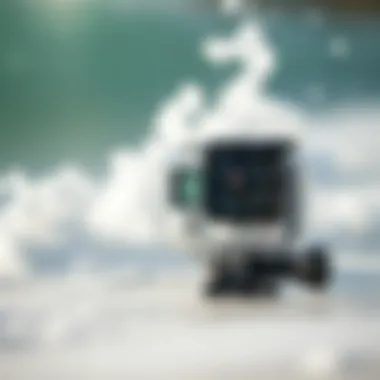
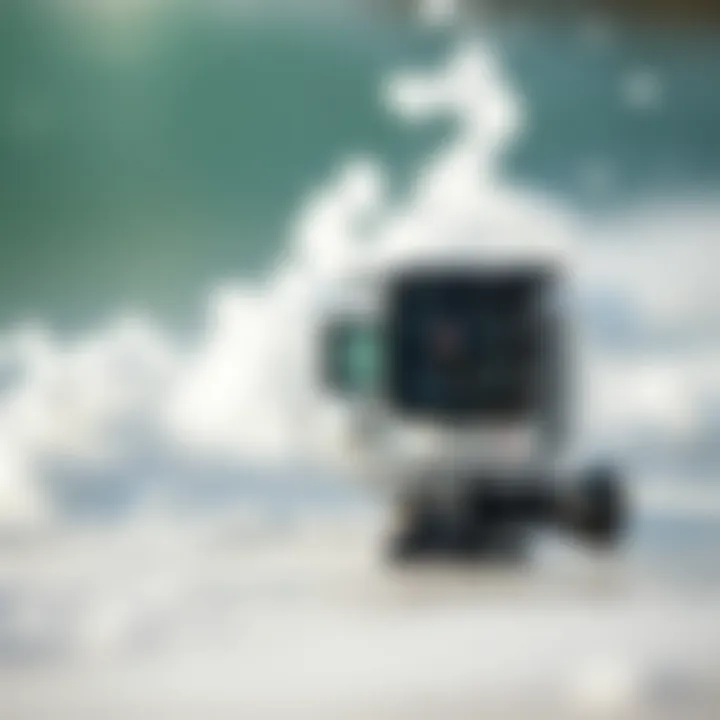
Low Light Considerations
Light conditions can change quickly on the water, so considering low light options is essential. The GoPro Hero3 can capture decent footage in lower lighting, but there are techniques to maximize its potential during such conditions. For example, adopting a slower shutter speed can help gather more light and illuminate the scene better.
However, it’s worth noting that shooting in low light can introduce noise or grain, which affects the overall quality. Riders must balance light settings while considering other variables that come into play.
Tips for Capturing Action
Capturing action effectively requires a blend of timing, knowledge of camera settings, and technique. The GoPro Hero3 provides several ways to improve your captures in dynamic situations.
Frame Rate Adjustments
Adjusting the frame rate can significantly impact how action sequences are depicted. Higher frame rates are ideal for capturing fast movements without blurring, making them an invaluable tool for kiteboarding recording. 60fps or even higher rates can yield crisp frames essential for analyzing techniques or simply showcasing high-speed thrills.
The ability to adapt the frame rate to the action at hand can set your footage apart, but it also requires understanding the right settings for varying conditions.
Image Stabilization
The GoPro Hero3 features impressive built-in stabilization, crucial for maintaining smooth footage amidst rapid movements and turbulence. This characteristic is particularly valuable for kiteboarding, where choppy water conditions and fast-paced maneuvers can easily lead to shaky recordings.
While the stabilization technology can be a lifesaver, it doesn’t always eliminate all imperfections. Riders should supplement with proper mounting techniques to achieve the best results.
Timing the Shot
Finally, timing is essential; capturing the right moment can transform an ordinary shot into something extraordinary. Understanding when to click the shutter—like when a rider is about to take off or land—requires practice and an inherent sense of timing.
Being in-the-moment and anticipating moves will determine the effectiveness of your footage. And while spontaneous shots can yield unexpected gems, carefully timing your shots pays dividends in the overall quality of your kiteboarding narratives.
Post-Capture Techniques
After capturing those exhilarating moments on the water, the next crucial step is managing the footage you've created. This section uncovers the post-capture techniques that can aid kiteboarding filmmakers in preserving their adventures in the most effective ways possible. It's not just about shooting well; how you handle the footage afterward can make all the difference, allowing kiteboarders to tell compelling stories with their films.
Transferring Footage
USB Connections
USB connections provide a straightforward way to transfer footage from your GoPro Hero3 to a computer. By connecting your camera directly using a USB cable, you can quickly move large files without hassle. This method is often favored for its reliability. A key characteristic is the universal compatibility of USB, making it a beneficial choice across various devices.
However, a limitation might arise when it comes to speed. While generally efficient, transferring large video files can feel slower compared to other methods, especially if you have hours of content to sift through. That said, this direct approach is particularly useful when you want to ensure all files are copied accurately, minimizing the risk of corruption.
Wireless Transfers
Wireless transfers have carved a niche for themselves as a more modern alternative to traditional methods. Utilizing Wi-Fi capabilities, you can send your footage straight to your smartphone or laptop without the need for cables. The convenience is a notable advantage here; just a few taps and you’re starting the transfer.
Yet, it’s important to consider that wireless transfers can be inconsistent. Factors like distance from the router or interference can slow down your transfer speed. Additionally, if you’re planning to handle large file sizes or high-resolution videos, this method might not be as efficient as you’d hope, occasionally leading to dropped connections.
Cloud Storage Options
In an age where access to your content anytime is essential, cloud storage options have become quite appealing. Saving your footage to platforms like Google Drive or Dropbox allows kiteboarders to easily access their videos from anywhere. This flexibility is a major plus when you’re on the go, allowing you to share footage with friends or on social media without being tethered to a single device.
However, cloud storage isn’t without its pitfalls. Uploading large video files can take considerable time, especially if your internet connection isn’t robust. Furthermore, storage space might be limited in some plans, making it necessary to manage what you keep up there actively. But once you get the hang of it, it can be a brilliant way to ensure your footage is safe and sound.
Editing Your Videos
Software Recommendations
Choosing the right software is pivotal for kiteboarders looking to polish their videos. GoPro’s own editing software, Quik, is user-friendly and well-suited for those who prefer a simple, drag-and-drop interface. This software allows quick adjustments, applying filters, and adding music with minimal fuss.
However, if you're looking for something with more capabilities, Adobe Premiere Pro or Final Cut Pro might suit your needs better. Both offer extensive editing tools and effects, giving you room to lure in viewers with seamless transitions and high-quality graphics. The trade-off here is a steeper learning curve that comes with using advanced software.
Basic Cutting Techniques
Learning some basic cutting techniques can significantly elevate the quality of your video. Understanding how to trim unwanted sections or stitching clips together can help create a more engaging narrative. One popular technique is the "J-cut," where audio from the next clip begins before the visual cuts, creating smoother transitions.
While these techniques are simple, they can make a noticeable difference in the overall professionalism of your videos. The goal is to keep your audience interested, and effective cutting can go a long way in achieving that.

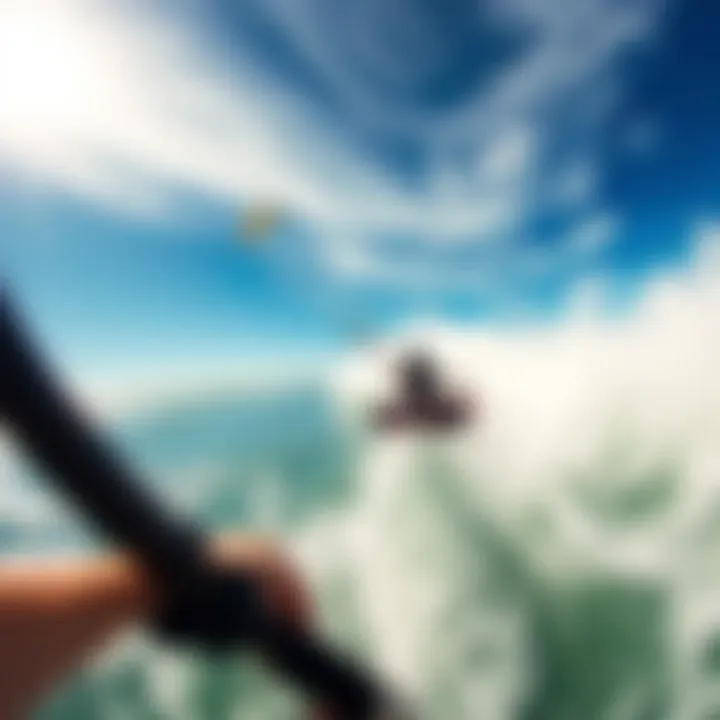
Enhancing Video Quality
Enhancing video quality can often mean the difference between a good and an unforgettable kiteboarding video. Employing filters and color correction tools can amplify the vibrancy of your footage, making the water look more inviting and the sky more majestic. Sometimes, even slight adjustments in brightness and contrast can breathe new life into a dull shot.
However, too much enhancement might make your footage look unrealistic or artificial. Therefore, maintaining a careful balance is key. By mastering these enhancemnets, you can ensure that your kiteboarding escapades are showcased in their best light, attracting viewers and fellow kiteboarding enthusiasts alike.
Where to Purchase the GoPro Hero3
Finding the right spot to buy the GoPro Hero3 is crucial for kiteboarders looking to capture their skills on camera. The process has numerous routes, each with pros and cons, whether you're a seasoned rider or a beginner wanting to document your first attempts. The decision can impact most facets of the purchasing journey, ranging from price to availability. Let’s dig into the different avenues available for purchasing this popular action camera.
Retail Options
Online Retailers
Online retailers have made waves in how we shop, and buying the GoPro Hero3 is no different. Convenience is key here; with just a few clicks, you can place an order from the comfort of your home. Platforms like Amazon, Best Buy, or B&H Photo Video often offer competitive prices, along with customer reviews that can guide your decision.
One of the standout features of shopping online is the sheer variety of options at your fingertips. When unsatisfied with one price, it's easy to browse and compare across different websites. However, pay attention to shipping costs and delivery times, as they can sometimes throw a wrench in what seemed like a great deal. For kiteboarders eagerly waiting to hit the water, timely delivery can be just as important as the price itself.
Physical Stores
There’s something about holding a camera in your hand before making a purchase that online shopping doesn't offer. Physical stores, such as local electronics outlets or specialty camera shops, allow customers to do just that. You can examine the GoPro Hero3, get a feel for its size, test functions, and maybe ask a staff expert about its features specific to kiteboarding.
Nevertheless, one downside can be limited stock. Sometimes, a popular model may be out of reach if demand is high. Additionally, prices might be higher than those found online due to overhead costs. Yet, if you want immediate gratification, there’s nothing quite like walking out with the new camera, ready to hit the beach.
Used Equipment Markets
For many, buying used gear is a practical move, especially if it means scoring a deal on a high-quality camera like the GoPro Hero3. Websites like eBay or Craigslist can lead you to great bargains, sometimes at a fraction of the retail price. Another appealing characteristic is that these platforms often have community feedback, giving buyers an extra layer of assurance about their purchase.
However, caution is warranted here. The risk of purchasing equipment with unseen damage exists, and returns might not be as straightforward as with new items. Therefore, it’s beneficial to ask for pictures, guarantees, or even a demonstration before sealing the deal, ensuring you’re not buying a pig in a poke.
Price Comparison
When it comes to purchasing the GoPro Hero3, price isn’t just about the upfront cost; it encompasses overall value as well. Making a savvy choice involves delving into the features offered against the price tags attached.
Evaluating Cost vs. Features
Understanding the balance between cost and features can save you dollars down the line. The GoPro Hero3 comes with various specs that cater to kiteboarding. Features to consider include image quality, waterproof capabilities, and battery life. Sometimes, opting for more features means spending more, but those additional capabilities can be invaluable in capturing stunning footage on the water.
One key takeaway is to map out what features you truly need against what your budget allows. If you’re an advanced kiteboarder needing top-of-the-line specs, investing in the right model is paramount. On the other hand, if you’re starting, a more budget-friendly version may suffice.
Discounts and Promotions
Keeping an eye out for discounts or promotions is beneficial. Many online retailers and physical stores hold seasonal sales or flash deals that can significantly reduce the price of the GoPro Hero3. Signing up for newsletters or following social media accounts of your favorite retail stores can also keep you in the loop for any upcoming sales.
Always check for promo codes online, as many websites now offer temporary discounts for first-time buyers or loyal customers. Plan your purchase around holiday sales, like Black Friday or Cyber Monday, to snag a deal that makes the investment feel a bit lighter on the pocket.
Warranty Considerations
Finally, considering the warranty of your purchase is essential to ensure your investment lasts. GoPro typically provides an industry-standard warranty period, offering peace of mind should anything go wrong with your camera. Make sure to read the fine print, especially regarding what is covered under the warranty. This could save you potential repair costs in the future.
Some physical stores may even offer their extended warranty options which can be an added bonus for buyers who might worry about wear and tear. Just remember that warranties are only as good as the fine print—ask questions if you're uncertain.
Purchasing the GoPro Hero3 doesn’t just end with choosing the model; it’s about weighing options to find the best fit for your needs, ultimately enhancing the kiteboarding experience.
The End
In wrapping up this exploration of the GoPro Hero3, it’s vital to emphasize its essence as an unparalleled companion for kiteboarding filmmakers. This camera stands out due to its impressive image quality and user-friendly design, making it a top pick for both rookies and veterans alike. The ability to capture the thrill of riding the waves while maintaining a compact, durable form factor opens up doors for creativity and storytelling.
Summarizing Key Takeaways
When considering the GoPro Hero3 for kiteboarding, a few key highlights come into play:
- Outstanding Versatility: Thanks to its mounting options, you can experiment with different perspectives—from breathtaking overhead shots to close-ups that capture the rider’s excitement.
- Adaptability in Various Conditions: The camera performs admirably in both sunlit and low-light conditions, fulfilling the needs of those who kiteboard at all times of day.
- Easy Editing and Sharing: With straightforward transfer capabilities and software options for editing, filmmakers can seamlessly refine their raw footage into polished presentations.
These features collectively augment the kiteboarding experience. The Hero3 ensures that every flip, jump, and powerful wave is immortalized, enabling athletes to relive their adventures and share moments with likeminded enthusiasts.
Final Thoughts on the Hero3’s Value
Ultimately, the GoPro Hero3 emerges not just as a technical device, but as an essential part of the kiteboarding experience. Its capacity to capture stunning footage brings an artistic touch to the sport, transforming personal escapades into visual tales. The camera’s resilience against nature’s elements means it is always ready to travel, ride the currents, and document those life-affirming moments.
For kiteboarders considering their options, investing in this camera could be a game-changer. Think of it this way: while the beach offers exhilarating waves, the Hero3 ensures that those adventures are never forgotten, allowing you to hold onto memories long after the sun sets on your kiteboarding day. Whether showing off your skills to friends or simply cherishing your journeys, the GoPro Hero3 remains a worthy addition to your gear, poised to elevate your kiteboarding story to new heights.









